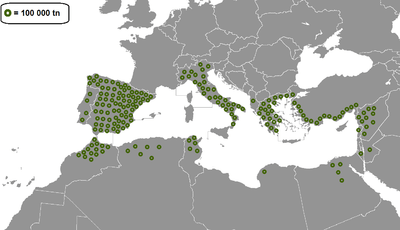Recently Paul Whitelock wrote about an important local crop that is harvested by hitting trees with sticks, namely almonds. He’s since come across two other significant crops that are harvested in the same way, by spreading nets on the ground beneath the tree and then hitting the branches with sticks. Here’s his report…
Chestnuts
Castañas are harvested in the same way as almonds, although later in the year, in October/November, depending on the weather and how well the nuts have ripened. Chestnuts represent an important crop in the Serranía de Ronda, especially in the Genal Valley based around the villages of Parauta, Cartajima, Pujerra and Igualeja. Genalguacil, Jubrique, Faraján, Benalauría, Benadalid and Algatocín also have chestnut forests. Annual production is around 4,500,000 kilos from 3,500 hectares of forest.
However, total Spanish production has declined from 37, 500 tonnes in 1979 to 15,000 tonnes in 2018, yet Spain remains the eighth highest producer in the world.
The name “chestnut” is derived from an earlier English term “chesten nut”, which descends from the Old French word chastain (Modern French, châtaigne). The French word in turn derives from Latin castanea (also the scientific name of the tree).
The wood is also used, for example in carpentry and furniture making. Castanets used by flamenco dancers are also made from chestnut wood – hence the name castañuelas.
Olives
Olives are extremely important throughout the whole of the Serranía de Ronda and is the principal crop in many villages. The harvest is taking place right now and many workers drop their other “jobs” to join in the harvest. Olives are either steeped in salt and then bottled with garlic, peppers and other vegetables and spices, in order to produce table olives, or they are crushed to produce olive oil. About 90% of all harvested olives are turned into oil, while about 10% are used as table olives.
Spain is the world’s largest producer of olives, indeed even exporting vast quantities of the raw material to Italy where producers there put the final touch and can then sell the resulting oil as Italian! In 2016 Spain produced 6,560,000 tonnes of olives from 2,573,000 hectares.
Interestingly, the 10 largest producing countries, according to the Food and Agriculture Organization, are all located in the Mediterranean region and produce 95% of the world’s olives.

Olive production by country in the Mediterranean basin. Each circle symbolises 100,000 tons of olive production.
| Main countries of production (Year 2016 per FAOSTAT) | |||
| Country/Region | Production (tonnes) |
Cultivated area (hectares) |
Yield (tonnes/ha) |
| World | 19,267,000 | 10,650,000 | 1.8091 |
| European Union | 11,686,528 | 5,028,637 | 2.3240 |
| Spain | 6,560,000 | 2,573,000 | 2.5490 |
| Greece | 2,343,000 | 887,000 | 2.6414 |
| Italy | 2,092,000 | 1,165,000 | 1.7950 |
| Turkey | 1,730,000 | 846,000 | 2.0460 |
| Morocco | 1,416,000 | 1,008,000 | 1.4044 |
| Syria | 899,000 | 765,000 | 1.1748 |
| Tunisia | 700,000 | 1,646,000 | 0.4253 |
| Algeria | 697,000 | 424,000 | 1.6437 |
| Egypt | 694,000 | 67,000 | 6.7293 |
| Portugal | 617,000 | 355,000 | 1.7394 |
I am reliably informed that you need three kilos of olives to yield one litre of oil. However, most oil processing plants have a minimum requirement of around 300 kilos per batch. So nothing doing for the 20 kilos I harvested last week from my one and only tree. I’ve got them steeping in brine in a plastic container in my garage and will hopefully be able to serve some of them as an aperitivo at Christmas.
The wood from olive trees is also put to good use. It is very hard and is prized for its durability, colour, high combustion temperature, and interesting grain patterns. Because of the commercial importance of the fruit, and the slow growth and relatively small size of the tree, olive wood and its products are relatively expensive. Common uses of the wood include: kitchen utensils, carved wooden bowls, cutting boards, fine furniture, and decorative items.
The final important crop in the Serranía de Ronda is the grape, which will be the subject of a future article.
